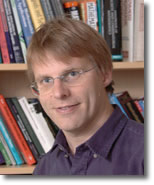|
TOWARD A SCIENCE OF CONSCIOUSNESS The Tucson Conference 2014 - 20th Anniversary APRIl 21-26, 2014 Tucson - University Park Marriott under the direction of the Center for CONSCIOUSNESS STUDIES, University of Arizona
2014 Pre-Conference Workshop
From Phenomenology to Consciousness, and back: Integrated Information Theory 3.0 Presenter: Giulio Tononi, Department of Psychiatry, University of Wisconsin Date: Tuesday morning, April 22, 2014 Session: 9:00 AM - 1: 00 PM Room: tba
Plenary Speaker TSC 2014 From Phenomenology to Consciousness, and back: Integrated Information Theory 3.0 Integrated information theory of consciousness (IIT) has recently attracted attention among consciousness researchers. IIT stems from thought experiments that lead to phenomenological axioms and ontological postulates (information, integration, exclusion, and compositionality). According to IIT, an experience is a maximally irreducible conceptual structure, which in principle can be completely characterized, both in quantity and quality, by determining to what extent a system of causal mechanisms is irreducible to its parts. Many observations concerning the neural substrate of consciousness fall naturally into place within the IIT framework. Among them are the association of consciousness with certain neural systems rather than with others; the fact that neural processes underlying consciousness can influence or be influenced by neural processes that remain unconscious; the reduction of consciousness during dreamless sleep and generalized epileptic seizures; and the distinct role of different cortical architectures in affecting the quality of experience. The tutorial will i) introduce the basic notions of IIT to a broad audience without requiring a mathematical background, and provide hands-on examples in which integrated information can be computed rigorously; ii) introduce measures of integrated information that can be applied to empirical data and discuss how they can be applied to evaluate the level of consciousness in wake, sleep, anesthesia, and disorders of consciousness; iii) demonstrated how integrated information grows in animats adapting to a complex environment, thereby shedding light on the evolution of consciousness; iv) consider theoretical and practical aspects of measures of integrated information, potential problems, and future developments. Overview of the tutorial Motivation of Integrated Information Theory of Consciousness (IIT) Phenomenological axioms (existence, composition, information, integration, exclusion) Ontological postulates (existence, composition, information, integration, exclusion) Basic concepts - Information from the intrinsic perspective of a system: Measuring “differences that make a difference” - Integrated information: measuring “irreducibility” - Identifying concepts (maximally irreducible cause-effect repertoires) - Identifying complexes (maximally irreducible sets of concepts) - An experience as an integrated information structure or “quale” Hands-on examples: calculating qualia for simple systems Some implications of IIT: - Systems condense into major complexes, minor complexes, and residual interactions - Simple systems can be conscious - Complicated systems can be unconscious - Inactive, but not inactivated systems, can be conscious - Feed-forward systems are unconscious - Functionally equivalent systems can be conscious or unconscious (true zombies) - A quale is self-generated, self-referential, and holistic Practical measure of integrated information Estimating integrated information via Lempel-Ziv complexity of human TMS-EEG data from sleep, anesthesia, and disorders of consciousness - Estimating integrated information via mismatch decoding of monkey ECoG from sleep and anesthesia - Discussion: Open issues and future developments Integrated information, artificial intelligence, and the evolution of consciousness - Matching: changes in integrated information reflect the incorporation of the causal structure of an environment within a brain - Integrated information grows with fitness: evolving animats - Discussion: why did consciousness evolve? Concluding remarks
General discussion
Professor, Department of Psychiatry University of Wisconsin-Madison Neuroscience Training Program Research Focus: Neural Basis of Consciousness; Functions of Sleep Research Strengths: Behavior: Cognition and Emotion, Neural Circuits
Giulio Tononi is a psychiatrist and neuroscientist who has held faculty positions in Pisa, New York, San Diego and Madison, Wisconsin, where he is Professor of Psychiatry. Dr. Tononi and collaborators have pioneered several complementary approaches to study sleep. These include genomics, proteomics, fruit fly models, rodent models employing multiunit / local field potential recordings in behaving animals, in vivo voltammetry and microscopy, high-density EEG recordings and transcranial magnetic stimulation in humans, and large-scale computer models of sleep and wakefulness. This research has led to a comprehensive hypothesis on the function of sleep, the synaptic homeostasis hypothesis. According to the hypothesis, wakefulness leads to a net increase in synaptic strength, and sleep is necessary to reestablish synaptic homeostasis. The hypothesis has implications for understanding the effects of sleep deprivation and for developing novel diagnostic and therapeutic approaches to sleep disorders and neuropsychiatric disorders. Another focus of Dr. Tononi’s work is the integrated information theory of consciousness: a scientific theory of what consciousness is, how it can be measured, how it is realized in the brain and, of course, why it fades when we fall into dreamless sleep and returns when we dream. The theory is being tested with neuroimaging, transcranial magnetic stimulation, and computer models. In 2005, Dr. Tononi received the NIH Director’s Pioneer Award for his work on sleep mechanism and function, and in 2008 he was made the David P. White Chair in Sleep Medicine and is a Distinguished Chair in Consciousness Science.
|
|
|||||||||||||
